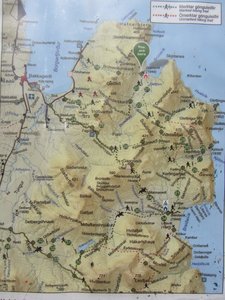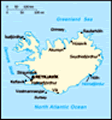Advertisement
Published: September 20th 2015

 Walking route map
Walking route map
These maps were located at various key points along the trailsWednesday 29th July
The eastern coast of Iceland is noticeable for the many fjords, and smaller bays, running roughly east-west. It is a popular hiking and horse riding area for Icelanders themselves as well as tourists. Many walking routes have been published and are clearly marked on local maps, and the area is well supplied with mountain huts in which to spend the night. The area we would be trekking in has no tarmac roads, and few gravel roads, but there are a number of dirt roads which tend to be much steeper and often cross rivers. Oskar had arranged for our minibus to be collected and substituted with an off-road jeep driven by his son. After breakfast at the Alfheimar we again made our packed lunch for the day, packed a day sack for ourselves, and then put the rest of our gear into the jeep which would be meeting us each evening at our mountain hut. We would be staying in 3 different mountain huts, reaching the town of Seydisfjordur on the fourth day.
Today we started by following the coast road around Borgarfjordur to Kolbeinsfjara, a few hundred metres before the puffin colony we had visited
yesterday at Hafnarholmi. There we turned off the road and followed the well sign-posted hiking route eastwards, up and over the saddle and down to the large Brunavik bay. Like many remote bays and fjords in Iceland, Brunavik had once been inhabited and we passed by the remains of a farmstead which was now abandoned. All that is there now is a mountain rescue hut in which it would be possible to spend the night if one was stranded here due to darkness or bad weather. After a short rest at the black sanded Brunavik beach we turned south towards the saddle at Suldskaro where we stopped for lunch. Most of the day's climbing had now been done and we continued steadily southward to Breidavik bay where our first mountain hut was situated. Oskar's son had arrived sometime earlier in the jeep and had put some cans of beer into the stream that ran by the hut. The weather was still quite warm so it was a pleasant end to the first day of our trek.
All three huts we stayed at consisted of 4 buildings. The first two, tonight's and tomorrow's, were identical in design. The third one,
on Friday night, would be to the same design but just slightly larger, intended for up to 40 people compared to the 30 of the first two. The main building has just three rooms. The entrance foyer is basically just a storage area and place to leave walking boots and hang up outdoor clothing. From the foyer there is a steep staircase up to the large single dormitory consisting of two long sleeping platforms covered with mattresses. Downstairs the foyer leads into the 'living room' which has 4 large tables with benches around, a sink, stove and wood-burning heater. The huts are supplied with bottled gas for cooking and with plenty of crockery and cutlery, you just need to bring your own sleeping bag and food and drink. Outside there is also a BBQ. The next building is the warden's hut. Wardens are voluntary and tend to stay for a week, receiving free accommodation in turn for looking after the place. The third building provides the washing facilities and has a shower room (slot machine requires coins to have hot water), a couple of toilets, and on the outside a couple of sinks. Finally there is the 'winter toilet', a
much smaller triangular building. The huts are normally available from May to September and area locked up and not used outside that period, but the warden's hut is left open as an emergency rescue hut. You can also camp at these huts as a cheaper alternative.
Thursday 30th July
As each of the huts we were staying at was at sea level, each day's walked basically consisted of an uphill section before lunch and a downhill section after lunch. Today we left the Breidavik hut and followed a 4x4 dirt track, initially west then generally south to the second hut at Husavik. Although spelt the same, this Husavik is very different to the town we visited a few days ago for our whale-watching trip. The Husavik hut is actually about a mile inland from Husavik bay itself but we did walk down to the bay first. This bay is still inhabited with a single occupied farmstead next to a tiny church on the cliff tops.
Friday 31st July
The third day's walking was the easiest day as again we followed a 4x4 track south over the next saddle and down to fjord of Lodmundarfjordur. After reaching
the side of the fjord, we then followed the northern shore of the fjord inland westwards to the Lodmundarfjordur hut. When at the Breidavik and at the Husavik huts we had been the only group actually staying overnight in the hut, though there were campers staying outside on both occasions. However at Lodmundarfjordur we were the only people there at all (apart from the warden). All the huts had visitors' books, however, and it was clear from looking at the comments left in them that these huts are regularly used by walkers and horse riders.
Saturday 1st August
For the fourth day of our trek we were again off-track as we followed the path eastwards along the southern shore of the fjord. This valley was again inhabited with a large farm that breeds eider ducks for their down - Saevarendi. On our right as we walked for a large part of the day was the massive grey mountain called Gunnhildur. Effectively we walked around 3 sides of this mountain and gradually descended to the northern shore of Seydisfjordur. Our trek was finished by walking alongside the road which then took us in to the town of Seydisfjordur where
we would be staying for the night. For visitors to Iceland who would like to take their own vehicles with them, Seydisfjordur is the destination of a vehicle ferry which starts from Denmark and also visits the Faroe Islands. In Seydisfjordur we stayed at the Hafaldan Hostel.
Sunday 2nd August
After breakfast in Seydisfjordur, we travelled in a minibus the 25km to the town of Egilsstadir where we were to catch a one hour flight back to Rekjavik, and then back to the Kex hostel. Here the organised tour ended; three of the group were flying back to the UK straight away, and the others the next morning, but I had elected to stay a few days longer, partly so that I could fly back to Birmingham rather than Heathrow, but also to give me a chance to visit a few well known tourist sites in the west of the country.
Advertisement
Tot: 0.092s; Tpl: 0.025s; cc: 13; qc: 28; dbt: 0.0435s; 1; m:domysql w:travelblog (10.17.0.13); sld: 1;
; mem: 1.1mb








